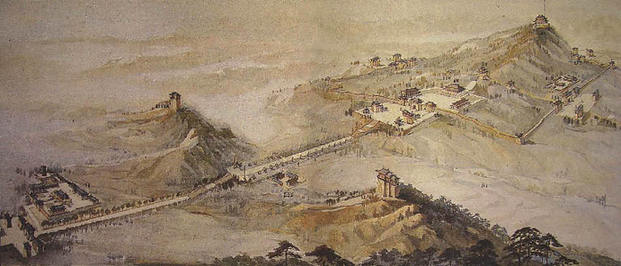|
The "Horsebreaker" Empress
Empress Wu Zetian was a skilled horse rider and breaker. As a low-ranking concubine of Emperor Taizong, she was often seen among the mounted entourage that accompanied the emperor on hunting tours. Once the emperor received a beautiful tribute horse from the Western Regions named "Piebald Lion," but no one could break him. The young concubine Wu volunteered to try, saying she needed three things: an iron whip, an iron hammer, and a dagger.
Wu Zetian explained that she first let the horse know the rules regarding what should be done and what shouldn't. When it failed to abide by those rules, she whipped it. When it failed again, she hammered it. Finally, if it still failed to obey, she killed it. The emperor was impressed with the beautiful woman's resolution and courage, but was also startled by her unrelenting high hand.
After Taizong died, Wu Zetian married his son, Emperor Gaozong. Later, when Wu Zetian became the imperial ruler after the death of Emperor Gaozong, she applied the horse rule successfully to the administration of the country, bringing the Tang Dynasty to its zenith.
Wu Zetian also loved horses. The Qianling Mausoleum, where Emperor Gaozong and Empress Wu Zetian are buried, has more stone horses than any other imperial mausoleum. Their stone entourage is led by a pair of winged steeds, named Celestial or Flying Horses, whose wings are carved in the pattern of swirling clouds. In addition, there are five pairs of saddled stone horses, each with a stone groom. Compared with those of the Zhaoling Mausoleum, the horse sculptures of the Qianling have stronger statures, thicker legs and a more imposing bearing, reflecting the great prosperity and power of the period they lived in.
The White Horse of Sacred Burden
 |
| A map of the Qianling Mausoleum. |
Twelve kilometers east of Luoyang City in Henan Province there is an ancient temple named the White Horse, distinguished by two stone horses that stand face to face in front of the entrance. Unlike the stone horses of imposing stature that guard ancient imperial mausoleums, the two sculptured animals look weary and peaceful.
The White Horse Temple has a history of 2,000 years. Historical records state that one night during the Eastern Han Dynasty (25-220), Emperor Mingdi dreamed of a five-meter-tall man whose head radiated golden light, coming from the west and flying around his palace. The next day, he told his dream to his ministers at the morning court hearing. One minister then reported that there was a deity in the west called Buddha like the man the emperor had dreamed of. The emperor then dispatched envoys to the west in search of Buddhist scriptures.
In AD 65, a delegation set out on the journey to the west. In Darouzhi (part of present-day Afghanistan), they met two eminent Indian monks and saw Buddhist scriptures and statues of Sakyamuni for the first time. They invited the two monks to China. In 67, the two monks set out with the Chinese delegation on a journey to the Eastern Han capital Luoyang, bringing along Buddhist scriptures and statues carried by two white horses. Emperor Mingdi ordered construction of a temple for the two Indian monks, and named it the White Horse in acknowledgment of the horses that carried the Buddhist treasures all the way to China. After the white horses died, the emperor had them buried by the temple. He also had two stone horses carved and placed at the temple entrance.
The White Horse Temple is famed as the number one ancient temple. It was once a Buddhist structure of magnificent scale, but went through several ups and downs in the chaos of the following dynasties. The present architecture covers 40,000 square meters, and dates mostly from the Ming and Qing dynasties. The two stone horses at the entrance are duplicates made in the Song Dynasty (960-1279). | 